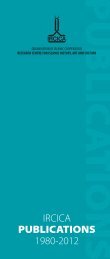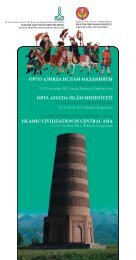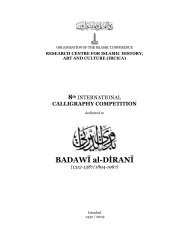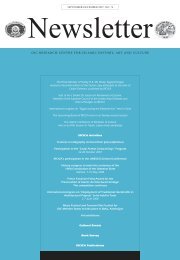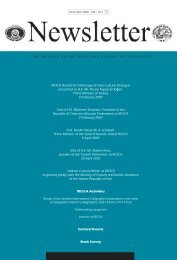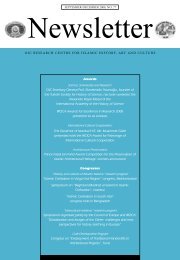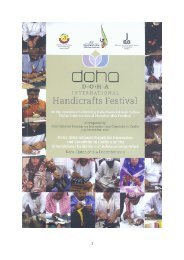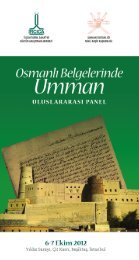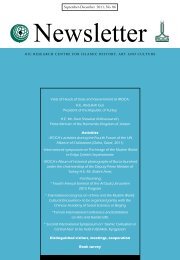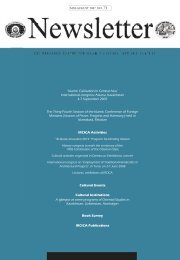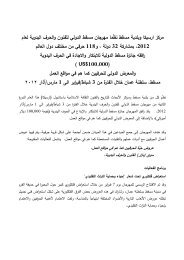You also want an ePaper? Increase the reach of your titles
YUMPU automatically turns print PDFs into web optimized ePapers that Google loves.
Book Survey»»»Recent acquisitions by IRCICA LibraryBook SurveyIslamic Art and Architecture in the European Periphery:Crimea, Caucasus, and the Volga-Ural Region,Edited by Barbara Kellner-Heinkele, Joachim Gierlichs,and Brigitte Heuer, Abhandlungen für die Kunde desMorgenlandes, Bd. 63, Wiesbaden: Harrassowitz, 2008,Paperback, 284 pp., 5 black-an-white illustrations, 139coloured illustrations, 24×17 cm.(to order: http://www.harrassowitz-verlag.de/)An important publication: this edited volume is the firstto deal comprehensively with the Islamic art, architectureand archeology of the eastern European periphery. It is acollection of current research on the northern littoral of theBlack Sea, the Crimea, the Caucasus, and the Volga-Uralregions, covering the time span from the Seljuk period tothe twentieth century. The majority of the articles containedin the book were presented as papers at the internationalsymposium on “Crimea, Caucasus, and the Volga-Ural Region:Islamic Art and Architecture in the European Periphery”which was organised by the editors of this book in Berlin,2004. The symposium aimed, as explained in the editors’Preface, to give a voice to historians of art and architecture,archeologists, curators of museums etc. from the region andinitiate a dialogue with their colleagues in Western Europein the study of the art and architecture of the Black Sea area,the Caucasus and Volga-Ural region. The resulting book willfurther contribute towards this aim: it brings together a largenumber of research articles by specialists from those regionsincluding those that were obtained after the symposium. It hasthus been possible to cover more of the different parts of thevast geographical area and the long time period under study.The editors note that at the same time, however, many otheraspects of the subject could not be covered. Thus through thesymposium and the book, it has been possible to assess thestate of the art and to pinpoint the topics that need to be takenup in future research. Joachim Gierlichs’s article “NeglectedResearch Topics – Some Remarks” at the beginning of thebook addresses the latter.The authors are researchers and museum specialists fromGeorgia, Germany, the Russian Federation, Turkey, andUkraine. A number of articles focus on recent archaeologicalexcavations and ongoing restoration projects. Others dealwith traditional applied arts and architectural decoration,as well as development of graphical arts, painting, andarchitecture in the modern period. A third group presentsspecial museum collections in Berlin, Dresden, and Tbilisi,and discusses neglected research topics, such as medievalart in the Northern Caucasus and the Islamic heritage inDaghestan and Georgia. The 21 articles are accompanied by139 unpublished photographs in colour.This book will be of interest to historians of Islamic art,architecture, and archaeology, turkologists, specialists inIslamic studies, Iranian studies, and Caucasian studies,historians of Eastern Europe, archaeologists, and museumcurators. The editors: Barbara Kellner-Heinkele is Professor ofTurkic studies, Director of the Institut für Turkologie/Instituteof Turkology at Freie Universität Berlin/Free University ofBerlin until 2007, and co-editor of Turkologischer Anzeiger,Dr. Joachim Gierlichs is Lecturer in Islamic Art History at theInstitute of Turkology, Free University of Berlin, currentlyworking on a project on “Woodwork of the Timurid Periodin Iran and Central Asia”, and since November 2007, Curatorat the Museum of Islamic Art, Doha, Qatar; Brigitte Heueris sociologist, academic collaborator in the research project“Language Reforms in the Ex-Soviet Muslim States” at theInstitute of Turkology, Free University of Berlin, and Lecturerin Sociology in the MA program “Central Asia and Caucasus”at the Central Asian Seminar, Humboldt University ofBerlin.Peter Schneider, Die-Rizk Moschee in Hasankeyf,Bauforschung und Baugeschichte,German Archaeological Institute, BYZAS 8, EgePublications, Istanbul, 2008, 2 vols., XVII+268 p., 75tables (in German)This book is an extensive study on the Rizk Mosque inHasankeyf which was built by the Ayyubid Sultan Sulaimanin 1409. The study is set against the background of the urbanhistory and the architecture of northern Mesopotamia andsoutheastern Anatolia in the 15th century. The publication isanother outcome of the importance attached to research onarchitectural history in Turkey and the cooperation betweenTurkey and Germany in this field.Today the historical Rizk Mosque is faced with the danger ofbeing flooded under the waters of a dam planned in the area.The position of the mosque has geographical and historicalimportance. It is situated at the intersection of the roadsextending from Syria to Central Anatolia and Northern Persia.Throughout history, these routes established the connectionin various directions.This work, a serious contribution to the architectural andcultural history of Mesopotamia in the 15th century, fillsimportant gaps of information. It gives a detailed descriptionand analysis of architectural features of the mosqueincluding its portals, iwan, minaret, decorative elements and20 Newsletter September -December 2009, No: 80





